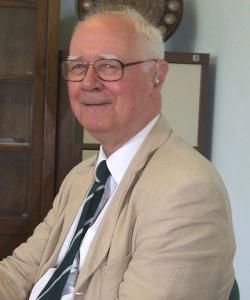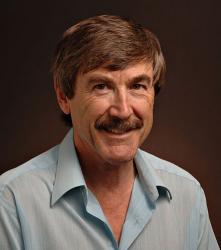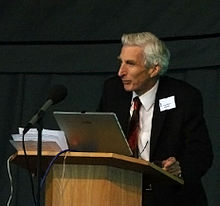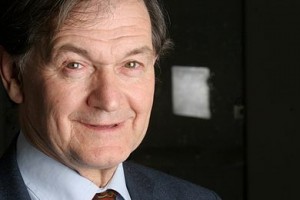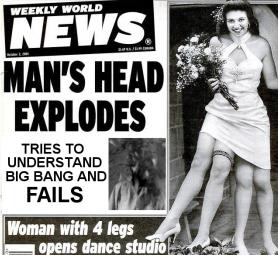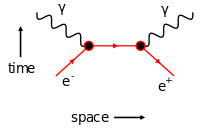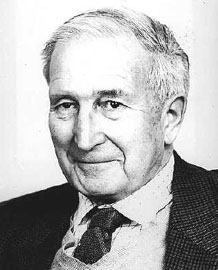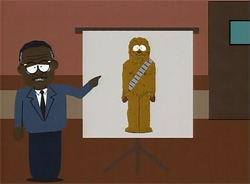John Polkinghorne, KBE, FRS. He loves
science and loves Jesus. My kind of guy.
![]()
Where were you when I laid the earth’s foundation? — God, speaking to Job (NIV)
![]()
A Quote From A Scientist!
(That’s an old joke from my time in online Origins discussions.)
Dr. Paul Davies, Astrobiologist. One
of the original “fine tuning” guys.
Dr. Paul Davies (whom I’ve mentioned previously) was awarded the Templeton Prize in 1995 for Progress in Religion. This is from his acceptance speech:
“If we could twiddle a knob and change the existing laws, even very slightly, the chances are that the universe as we know it would fall apart, descending into chaos. Certainly the existence of life as we know it, and even of less elaborate systems such as stable stars, would be threatened by just the tiniest change in the strengths of the fundamental forces.
“The laws that characterize our actual universe, as opposed to an infinite number of alternative possible universes, seem almost contrived-fine-tuned, some commentators have claimed, so that life and consciousness may emerge. To quote [physicist Freeman] Dyson again: it is almost as if ‘the universe knew we were coming.’
“I cannot prove to you that this is design, but whatever it is, it is certainly very clever.”
Dr. Freeman Dyson in front of a chalkboard
full of Incomprehensible Geek Stuff(tm).
A Cosmos Fine-Tuned For Life
Davies was speaking in 1995. More recently, John Polkinghorne (pictured above) — Mathematical Physicist, one-time Dean of Queen’s College at Cambridge and an ordained Anglican minister — said this about our Cosmos (from the Q/A section of his website; my [comments] are in brackets):
- No competent scientist denies that if the laws of nature were just a little bit different in our universe, carbon-based life would never have been possible. Surely such a remarkable fact calls for an explanation. If one declines the insight of the universe as a creation endowed with potency, the rather desperate expedient of invoking an immense array of unobservable worlds [i.e., the “many worlds/multiverse/’unlimited horizons'” proposals] seems the only other recourse.”
Some will immediately pounce on what they think is a qualifier in that comment: “carbon-based life.” More on that a bit later.
There is a consensus among cosmologists that our universe appears to be fine-tuned for life. There are questions about the details and debates over what it means, but there is broad general agreement on this nowadays … regardless of what you might have read elsewhere. (*cough*)
(In fact, here’s a freebie for my skeptic/atheist friends: if you insist on avoiding a Theistic conclusion, go with a Multiverse. That’s the trend nowadays, not nitpicking the “fine-tuned cosmos” stuff. Don’t take my word for it, click the links that I’ve provided.)
Dr. Sandra Faber. Award-winning astrophysicist (including the
National Medal of Science). Helped design the Keck Telescopes.
An atheist. Believes that our universe is fine-tuned for life.
![]()
Other References
The caption for Dr. Faber’s image (above) includes a link to a nice PBS story on this. I was also delighted to find this laycreature-level discussion from 2011 at Harper’s Magazine. Both reinforce what I said in the introduction: given the fine-tuning in our cosmos, either there’s a Creator or there are other universes. (Of course, the latter is the focus of both of these articles).
For a uniquely Christian perspective, The Reasons To Believe Website is a good place to start. Dr. Hugh Ross is sometimes criticized for rushing to conclusions on skimpy evidence (Dr. Luke Barnes, whom you’ll meet in a moment, is one such critic). But if you’re not a scientist and want a great, laycreature-level view from a conservative Biblical perspective, you can’t beat it.
For the actual Geek Stuff, arXiv (pronounced “archive”), maintained by Cornell University, is a good place for academic papers. You can search by subject, title, author and more. Two warnings: first, these are really, really Geeky and second, not all papers are of the same quality (in fact, some are downright bad) … but there’s some good stuff there if you’re willing to plod through it.
I’ve had very mixed luck with general Web searches lately. As I mentioned earlier, Google returns a mind-roasting mix of polemics and screeds. Wikipedia, while useful, sometimes gives too much weight to arguments that aren’t widely accepted. Its strength is also its weakness: anyone can edit it. People can (and do) go on there with pet theories and axes to grind. Here’s a tip: click the “Talk” tab on a page to see the discussion behind the text.
Baron Dr. Martin Rees, OM, Kt, FRS. An Atheist. Author (with
Dr. John Gribbin) of the classic Cosmic Coincidences on fine-
tuning for life in our Cosmos. (And he’d make a great Dr. Who.)
![]()
Stenger vs Barnes
One name often associated with “activist” atheism is the late Dr. Victor Stenger. The man was beloved of atheists who were trying to stamp out that aggravating fine-tuned Cosmos thing. After all, he was an accomplished particle physicist and philosopher who questioned many of its underlying assumptions. (He even wrote a bunch of books.)
Luke Barnes, an astrophysicist, has been an outspoken critic of Stenger. Barnes harshly criticized Stenger’s “MonkeyGod” program on his blog and finishes with,
- Allow me to state my conclusions with the kind of candour only allowed in the blogosphere: MonkeyGod is bollocks. It is worse than irrelevant – it is misleading …
- The worst part is that others are taking Stenger’s work as the definitive debunking of fine-tuning. [Stephen adds: I’ve seen this myself on the Web. Many skeptics apparently think that MonkeyGod rocks like the Stones.]
Barnes has also published a peer-reviewed, in-depth defense of a fine-tuned Cosmos (using as its foil Stenger’s The Fallacy Of Fine Tuning) (PDF). It’s one of the most devastating critiques I’ve ever read. It’s uber-geeky and filled with weird math that might cause your head to explode, though. (Unless you like weird math, of course. Or an exploding head. Otherwise, you have been warned.)
Roger Penrose, FRS is to mathematical physics what Titian was to oil and
canvas. An atheist. Believes that our cosmos is incredibly fine-tuned for life.
![]()
An Example Of “Fine Tuning” …
I’m not going to do the usual List Of Fine Tuned Stuff. (If you really want one, Dr. Ross has this list (PDF) at the Reasons to Believe Website.) I think it’ll be more fun to actually pick one example and walk through it, step by step.
We’ll start again about one millionth of a second after the Big Bang. The universe has cooled enough for the Four Fundamental Forces (a great name for a Pretty Boy Band, by the way) to split off. We’re left with a hot Quark-Gluon Plasma and now things get a bit crazy(er) for the next 10 seconds or so.
The strengths of the Four Fundamental Forces, the temperature at any given moment, the expansion rate and some other things had to work together perfectly for what I’ll show you next.
Things are still extremely unsettled and ridiculously hot (many billions of degrees). All sorts of strange things are happening: photons are energetic enough that some turn into electrons and anti-electrons (“positrons”). Anti-neutrinos can combine with protons to form a neutron and a positron. A neutrino and a neutron could combine to form a proton and an electron. And vice-versa. Both matter and anti-matter versions are created … .. .. wait, what?
This could be a problem. Matter and antimatter hate one another. They are equals-but-opposites that annihilate (i.e.,”boom”) when they come together, releasing pure energy.
The tragic demise of the Weekly World News is just one
more indicator of the continuing decline of civilization.
![]()
Matter vs. Antimatter (Matter wins. Barely.)
First, Quarks combine to make the Hadrons, including protons and neutrons, in both matter and antimatter varieties. Conditions are just right for us to end up with several times more protons than neutrons. This is a good thing, because once the madness is done, we’ll end up with mostly hydrogen and a smidge of helium. That’s a great mix to create the stars that will make the elements needed for life chemistry (we’ll cover that in the next section).
Unfortunately, at this moment, the madness isn’t done yet. Once the Cosmos cools a bit more, the matter and antimatter versions of the hadron particles have a throw down hissy fit: they annihilate like mad.
More time passes, more cooling … then, between 1 and 10 seconds after the Bang, the Leptons (including electrons) are created in both matter and antimatter flavors. These also annihilate each other like mad.
(By the way, what followed this second annihilation is called the photon epoch. These photons eventually became the source of the cosmic background radiation, one of the strongest evidences for a big bang.)
Everything that you see around you today is made from the relatively-few survivors (about .00000001%) from these two separate annihilation events. The most common theory is that a very slight asymmetry (called a “CP violation” by the propeller-heads) caused a bit more matter than antimatter to form. But that’s not the brain-bender.
An electron (e-) and an anti-electron
(or positron, e+) annihilate, releasing
two gamma rays (y). (y? Because.)
![]()
Here’s The “Coincidence:”
On a cosmic scale (don’t miss that) the numbers of electrons and protons must be equal to a very tiny fraction of a percent. If not, electromagnetic effects would dominate and overwhelm gravity. (It’s that old “like charges repel” thing.) Galaxies and stars couldn’t form, because the strength of the electromagnetic force is a billion billion billion billion (10 to the 36th, for those who like large numbers) times more powerful than gravity.
My more perspicacious readers will have figured out, however, that these numbers did work out perfectly, given that you are here to read this. Yep! For each and every lonely proton, E-Harmony can guarantee a sweet little electron, just waiting to form a nuclear bond. (D’aaaww!)
Victor Stenger has claimed that charge conservation would have guaranteed this, making it a non-issue. That is rejected by Barnes thusly: “[charge conservation] doesn’t imply that the net charge of the universe is zero, only that it be constant.” (Translation: Stenger is simply wrong.)
These particles were created in two separate events, each time annihilating one another like a swarming horde of blind-drunk rednecks with plasma cannons. Not once, but twice. And yet, we ended up with the same number of protons and electrons, and just the right mix of hydrogen and helium.
This. Times a zillion zillion zillion.
With plasma cannons. TWICE.
![]()
“Aw, C’mon, Poole!”
Now: those who disagree will raise any number of arguments to what I just said. The most common is, “of course it worked out this way, or we wouldn’t be here!” That’s just a laycreature’s variant of the Anthropic Principle. In practice, that person is simply saying, “I don’t care and I’m not impressed” — hardly a conclusive (and anything but a “scientific”) argument.
(If they’re really up on the lingo, they’ll call it “puddle logic.” You have been warned.)
Those with a more scientific bent will argue that it worked out so neatly because it had to. The laws of physics contained the slight asymmetries and other forces that caused a slight excess of matter over antimatter (twice), then forced the proton/electron ratio to be unity.
OK. But that doesn’t answer the question of why. Who or what caused our laws of physics to be so precisely-balanced that we would get exactly what we need for galaxies, stars and intelligent life from STUFF, and under conditions of absolute chaos?
“There’s no evidence that the laws of physics could be any other way,” you might then respond. OK again: instead of a Transcendent Creator, you prefer Transcendent Laws And Principles That Just Happen To Be So Incredibly Fine Tuned, They Create A Cosmos In Which People Like Us Can Argue And It’s No Big Deal(tm). Fine; that’s your choice. But recognize it for what it is.
Anthony Flew, one of the most outspoken atheists of the 20th century,
changed his mind because of mounting evidence for a fine-tuned Cosmos.
(Bonus: The link includes a scathing review of Dawkin’s The God Delusion.)
![]()
Another Example
The original Big Bang theory just said that the universe started really small and then became really big. Dr. Alan Guth then added the idea of cosmic inflation: for a brief moment right at the beginning, the universe expanded many times the speed of light. I haven’t even mentioned the fact that inflation had to have occurred precisely when it did. What’s intriguing is that the rate then slowed, just in time for everything to fall into place … but new research shows that it’s accelerating again!
(Not nearly as fast as during the original Inflationary Epoch, of course, but it seems the poor Cosmos can’t make up its mind!)
This is believed to be the result of Dark Energy, as discussed in this article on the Cosmological Constant. Whatever the precise cause, this value is extremely critical to a ridiculously-small fraction of a percent. If it was even a smidge faster, the early universe would have expanded uselessly; if a wee bit slower, the universe would have collapsed.
Those skeptics who have been hoping that new discoveries would crush and melt this whole “fine tuning” thingie are going to be disappointed. The trend is clear and in fact, the opposite has been happening for some time now. Someone will question one aspect of it (and which skeptics will immediately latch onto, of course). But like clockwork, within a year or two at most, another paper will appear saying, “yeah, about that … turns out the fine-tuning is even ‘finer’ than we thought.”
Click the links and read the books I mentioned in the introduction. As mentioned in that Harper’s article, Steven Weinberg, an imminent theoretical physicist and an outspoken atheist, has often questioned some aspects of fine-tuning himself. But now he has finally — grudgingly — come to accept the Multiverse idea as well. The evidence for fine tuning is overwhelming. People like Victor Stenger represent a tiny minority opinion, not the consensus.
Scientists say this is a neutron star. It’s not a
ghostly hand tossing a Molotov cocktail. Ha!
That’s just what they want you to believe.
![]()
“But Other Forces Could Be Adjusted To Compensate …”
This is another objection raised by Stenger and a few others. A typical “fine-tuning list” will contain things like, “if the Strong Force was a few percent different, we wouldn’t be here.” These folks correctly point out that you could “adjust” other parameters to compensate.
That’s true, but for the life of me, I don’t understand how they think this will help them. To once again quote Dr. Barnes (from his critique of MonkeyGod, linked above):
- Expanding parameter space into other dimensions opens up new possibilities for life-permitting universes, but also increases the amount of “dead-space” …
- Finding other possibilities for life is not the same as showing that life-permitting universes dominate the space of possible universes. Remember: the claim is not that ours is the only universe that could support life, or that we are the only possible form of life. The claim is that if a universe were chosen at random from the range of possible universes, the probability of that universe being able to support intelligent life is very small.
This is just simple math. If I give you a problem with two or three variables, that’s one thing. But each time I add another variable, yes, you have more opportunities to adjust for a specific result — but it becomes exponentially more difficult to get that desired end result. Nor (as Barnes carefully — and correctly — points out) does this somehow magically widen the opportunities for a life-friendly universe. In fact, the opposite is true.
Whether you choose a Lamborghini or a set of feet in shoes, it
takes more than “coincidences” to get from Point A to Point B.
![]()
Carbon Chauvinism?
Skeptics will immediately latch on what they think is a qualifier in Polkinghorne’s comment (see above): “carbon-based life.” They frequently object that carbon-based life as we know it may not be the only possible form. I can’t speak for anyone else, but I don’t have a problem with this.
Just as with the multiple-interdependent-parameter thingy discussed above, I also don’t understand how they think this could help them, either.
For the record, I agree that God could have made us as energy beings, or as blobs in a “mini-verse” the size of Rhode Island. Instead of stars, we might have had … Space Heaters! (Sorry. Couldn’t resist.)
Those who actually work with this stuff (as opposed to those who just argue about it) say you will need a mind-numbingly significant level of organization for any cosmos that will eventually develop intelligence — of any form. I don’t care what you propose or how you propose to do it.
By the way — if you argue that intelligence isn’t the ultimate goal, you didn’t just shoot your argument in the foot. You annihilated it like a redneck with a plasma cannon. I’ll let you figure out why as you hop back from the hospital.
In a universe the size of Rhode Island
everyone would have a 3-digit car tag.
![]()
The Appeal To Chewbacca
You want a really crazy example? Some scientists not only believe in the multiverse, they think that one day, you may even be able to create a universe of your own. While the very thought should send us screeching into the shrubbery (what could possibly go wrong?!?), we are fearless. We shall roll with it.
OK: your Acme Universe Kit has arrived in the mail. You’ve installed the batteries and all the blinkie lights look good. Your assignment is to create a little itty-bitty ‘verse with a single intelligence in it. Just one. That shouldn’t be too hard, should it?
You can set up your own physical laws, from the attractive forces to the binding forces to you name it. BUT … since any skeptic worthy of the label would insist that our current universe has no guiding intelligence, you shall press the little red button, fire off your version of a Mini-Big-Bang and just let it run. Hands off. Everything else must just fall into place, with no further tweaks or diddles from you.
Some time before your miniverse experiences its version of heat death, I want at least one sentient life form who is able to look around and ponder on what he/she/it/wibble/g’Ronk sees. Think you can do it?
The “carbon chauvinism” argument is an Appeal To Chewbacca. Let’s forge ahead.
It makes no sense.
![]()
Some Philosophical Objections
I’ll spend more time on the philosophical arguments against a Creator (and against Christianity in particular) in a later section; but let’s take a brief glance at a couple here.
Why is this cosmos the way it is? Assuming your Acme Universe Kit works and you actually succeed in creating sentience (congratulations!), two things will dawn on you. First, that you had to arrange the daylights out of that thing to make it work (in other words, intelligent design). Second, listening to your little sentience ask that question will give you a whole ‘nuther level of appreciation for the term, “irony.”
Quick (and better answer): ask God. Maybe He likes colorful flowers and stellar nebulae. Maybe He wanted you to enjoy this creation. He could have set things up so that everything was generic black and white, and we were giant, sessile blocks who ate carbo-proteins that grew in stone vats. Instead, He gave us feet and hands and steaks and music and chops and pizza and fresh-baked bread and songbirds. Maybe He loves us and delights, not only in His creation, but in giving us good things.
If this cosmos is “designed for life,” why is life so rare? Actually, there’s growing evidence that single-celled life may be quite common, at least in our little corner of the galaxy. The hard part is making intelligent life such as you and I. And this is where I part ways with some of the other “fine-tuning” folks: I believe that God actively worked within our universe to see to it that you and I would exist and be able to read this.
Another view of the Cosmos, from beginning to the present day.
Use the menu to the left or click here for a look at how stars create the elements for life chemistry.

